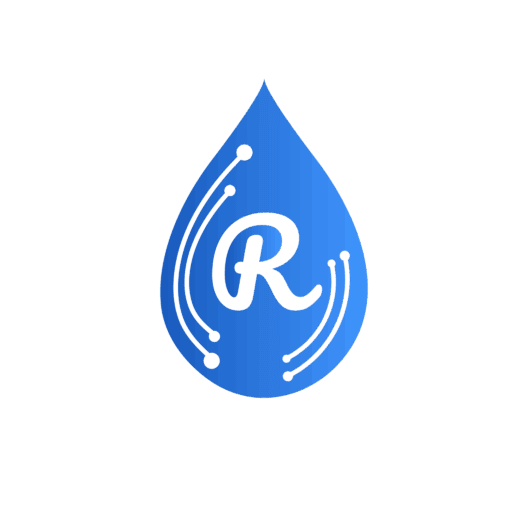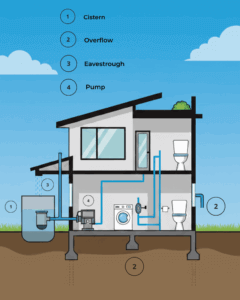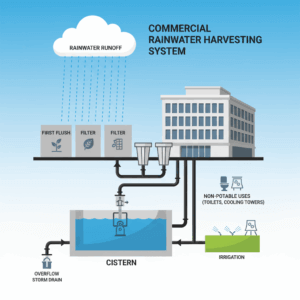Common Sense
Managing rain where it falls isn’t just a homeowner’s trick—it’s common sense infrastructure. By capturing roof runoff, property owners ease pressure on storm drains, reduce localized flooding, and save money on water. Whether it’s a modest barrel or a full-scale cistern, these systems turn everyday rainfall into a resource, not a nuisance.
Rain Barrels vs. Cisterns: What’s the Difference?
Collecting roof runoff is a bit like coupon clipping for water bills. Rain barrels capture water from downspouts and store it for your lawn or garden. Cisterns are the rain barrels’ bigger cousins, holding 200 to 10,000+ gallons. Both reduce runoff and provide free irrigation water, but the right choice depends on your roof area, space and ambition.
Sizing and Installation Tips
Sizing is key. A guideline suggests one 55-gallon barrel per 750-1,250 square feet of roof area. Barrels typically store 50-200 gallons; you can connect multiple barrels to increase capacity. Cisterns, which may be above- or below-ground, store more water and can be plumbed to drip irrigation lines or even toilets (with permits).
Installation is straightforward but not foolproof. Use gutters and downspouts that direct water to the tank. Install a mesh screen to keep debris and mosquitoes out and a first-flush diverter to discard the first, dirtiest runoff. Set the tank on a level foundation and plan an overflow route to a vegetated area or rain garden away from your foundation. Avoid using water from asphalt shingle roofs or wooden shakes on edible plants unless you treat it; heavy metals and microbes hitch rides on shingles.
Life After Installation: Pairing with Other Systems
Once installed, you’ll wonder why everyone isn’t doing it. Even capturing a small fraction of your roof runoff is a big boon.
Pairing rain barrels or cisterns with other green infrastructure creates a comprehensive home drainage system. Capturing runoff at the source reduces ponding around your foundation and pairs well with practices like permeable pavers and rain gardens. Directing cistern overflow to a rain garden can protect your yard from flooding and allow infiltration. Similarly, installing permeable pavers on walkways or driveways helps your property soak up water rather than shed it, reducing stormwater fees and preventing water damage.
Get Help with Rainplan’s Green Spending Assurance
If you want expert guidance, Rainplan’s Green Spending Assurance service can help you fund and implement these improvements. We’ll match you with the right contractor, provide initial payments so your project starts quickly, and help you apply for any available rebates or incentive programs.
Whether you need a simple rain barrel, a large cistern, a new rain garden, or permeable pavers, we’re here to help you maximize your investment by connecting you to the right people and programs. At the end of the day, there’s something deeply satisfying about watering your tomatoes with stormwater.



